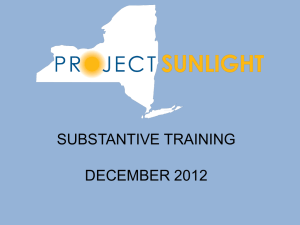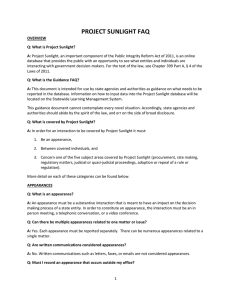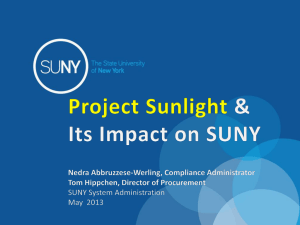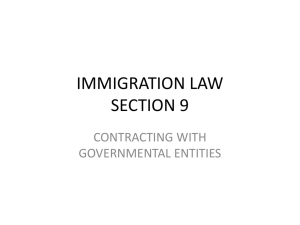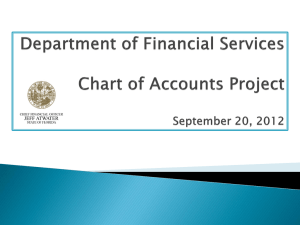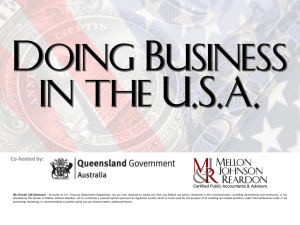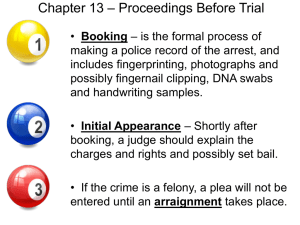NYS Project Sunlight Substantive Training Power Point
advertisement
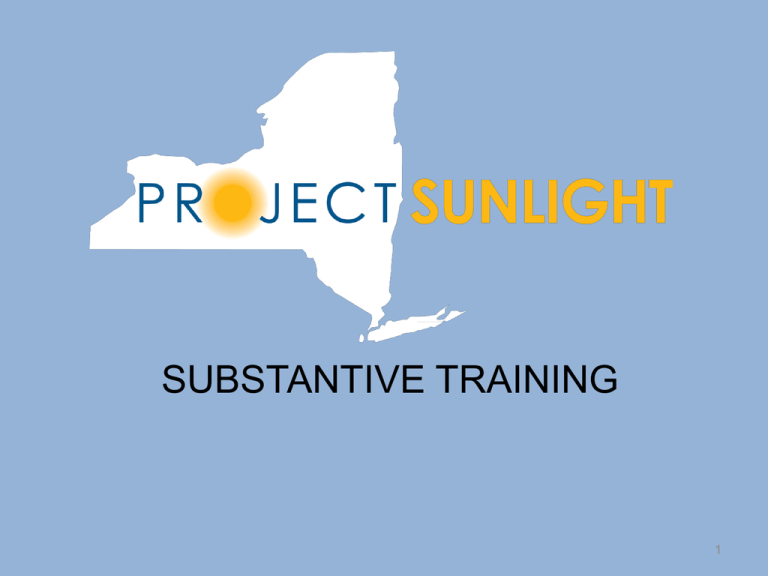
SUBSTANTIVE TRAINING 1 Introduction to Project Sunlight • Project Sunlight, an important component of the Public Integrity Reform Act of 2011, is an online database that provides the public with an opportunity to see what individuals and entities are interacting with New York State government. See Chapter 399 Part A, § 4 of the Laws of 2011. • The purpose of this training is to help state entities determine what needs to be recorded in the database. For further guidance, please see the Project Sunlight Policy and FAQ. • For technical training on how to use the Project Sunlight database, please see the Project Sunlight Technical training, available on the Statewide Learning Management System. • If you have questions about whether or not an appearance is covered by Project Sunlight, please contact your Agency Liaison. 2 What is covered by Project Sunlight? In order for an interaction to be covered by Project Sunlight, it must • Be an appearance, • Between covered individuals, and • Concern one of the five subject areas covered by Project Sunlight • • • • • procurement, rate making, non-statutory regulatory matters, agency-based judicial or quasi-judicial proceedings, adoption or repeal of a rule or regulation. 3 What is an appearance? An appearance must be a substantive interaction that is meant to have an impact on the decision making process of the state. Appearances are: • In-person meetings. • Video conferences. Written communications such as letters, faxes, forms, and emails are not considered appearances, and do not need to be reported. Telephone conversations are not considered appearances, and do not need to be reported. Appearances related to legislation and the budget are not covered by Project Sunlight. 4 Appearances, cont. • There can be multiple appearances related to one matter. For example, a lobbyist may meet with a state agency several times in an effort to repeal a regulation. Each meeting is a separate appearance. • The location of a meeting is irrelevant; it can take place in a government office, at a vendor’s headquarters, or at a coffee shop. • As a general matter, whomever initiated the interaction – whether it is the state entity or the outside individual or entity – is irrelevant. However, if the state entity wishes to meet with an outside individual or entity to gather information, that communication does not need to be reported. • The formality of the interaction is irrelevant; an informal meeting and a formal sales pitch can both be appearances. 5 Appearances, cont. • Merely ministerial interactions, such as scheduling a meeting, do not need to be recorded. • Participation in meetings which are open to the public, such as conferences or meetings under the Open Meetings Law or where a record of the meeting is otherwise available, does not need to be recorded. However, communications outside that meeting may be covered, such as an interaction after that meeting between a regulating agency and a regulated party during which the regulated party advocates for the repeal of a regulation. 6 Appearances, cont. • Confidentiality requirements imposed by federal or state statute, rule or regulation always take precedence over the requirements of Project Sunlight. Any interaction that an agency or authority treats as confidential pursuant to law, rule, or regulation does not need to be reported. • Any appearance that if disclosed could endanger the life or safety of any person does not need to be reported. 7 Who/What is a “Covered Individual”? • At the State entity? • Appearances should be recorded if they are conducted before an individual at the state agency who has the power to exercise agency discretion in one of the five covered categories, or advises someone who has that discretion • A temporary worker or independent contractor who has discretion in one of the five covered categories may also be covered by Project Sunlight • Agents of a state agency or authority, such as retained counsel, are not covered • The appearing entity? • Appearances by both “external” (e.g., a lobbyist) and “internal” (e.g., a general counsel) representatives of an entity must be reported • Appearances by an individual appearing on behalf of him/herself must also be reported 8 Entities and Individuals that are Excluded • The following entities are categorically excluded from the reporting requirement: • Appearances by other state and local agencies and authorities, as well as tribal governments and federal government representatives • Appearances by elected or appointed officials, executive or legislative employees, or judges or employees of the judiciary • Individual inmates and parolees and their representatives before state entities regarding their supervision and/or conditions of confinement • Representatives of the media • Persons under the age of 18 9 Types of Appearances An appearance must only be reported if it falls under one of the five following categories: • • • • • Procuring a state contract for real property, goods, or services Rate making proceedings Regulatory matters Agency-based judicial or quasi-judicial proceedings Adoption or repeal of a rule or regulation 10 Procurement • Appearances that are for the purpose of procuring a state contract, whether or not a specific procurement is anticipated, must be reported. • Accordingly, sales pitches may be considered appearances if they are before a decision maker. • However, appearances that occur during a Restricted Period under the Procurement Lobbying Act, and are therefore part of the Procurement Record, such as bid clarification meetings or bid interviews, need not be reported. 11 Procurement, cont. • Appearances that are at the request of a state entity that are informational, such as market research, do not need to be reported. • For example, if an agency reaches out to a M/WBE firm to determine interest in and availability to provide services or goods, that communication need not be reported. • Appearances following an award of a state contract do not need to be reported. • Appearances for the purpose of advocating for the receipt of discretionary state funds that have already been appropriated must be reported. However, requests for funding in the budget need not be reported. • Appearances related to procurements under $25,000 do not need to be reported. 12 Procurement, cont. • Appearances at a public auction as a buyer or on behalf of a buyer need not be reported. Agencies and authorities must still comply with any other laws and regulations regarding responsive buyers and/or reporting the final sale, if applicable. • Appearances related to emergency procurements do not need to be reported. • Participation in widely-attended industry or professional conferences, including attending panels, participating in training or educational programs, or visiting booths on a show floor or exhibit hall is not considered an appearance. • Appearances related to revenue contracts must be reported. Gifts, donations, or grants to the State that are not in exchange for real property, goods, or services do not need to be reported. 13 Rate Making • Agencies that conduct rate-making should record all applicable appearances that lead up to the setting of the rate. • Appearances outside of a formal rate making that are attempts to influence a rate should also be recorded. • Once the rate has been set, the only interactions that need to be recorded are appearances to attempt to influence the application of a rate to a particular client or entity or are part of advocacy for future rate changes. • Factual inquiries about rates that are purely informational need not be reported. However, if the interaction then turns to advocacy about that rate, the interaction may constitute a reportable appearance. 14 Regulatory Matters • A regulatory matter is one related to agency interpretation and enforcement of regulations and existing law. • An appearance regarding a regulatory matter need only be recorded if it occurs before a state employee who has the capacity to make or influence decisions about regulatory policy, as well as how a regulation should be enforced or interpreted. • The key is the level of discretion used when enforcing or interpreting an agency’s regulations. • Purely ministerial matters or interactions requesting information do not need to be reported. 15 Regulatory Matters, cont. •Many agencies enforce regulations by conducting inspections. An inspection itself, which is for information gathering purposes, is not to be reported in Project Sunlight. Ancillary or subsequent communications related to an inspection, such as contesting a finding, must, however, be reported. •Individuals may also contact an agency to file a complaint or inform the agency that a regulated entity is in violation of a regulation. Complaints, and subsequent investigations into those complaints, do not need to be reported in Project Sunlight. •In addition, each agency shall maintain a list of the types of regulatory matters that are not covered by Project Sunlight, and that list will be publicly available on the Project Sunlight website. 16 Judicial or Quasi-Judicial Proceedings • Judicial or quasi-judicial proceedings are proceedings that take place before a neutral arbiter at a state entity. • The state must be a party to the proceeding for such an appearance to be reported. If the state merely serves as a neutral arbiter or as a forum for two outside parties (such as providing an Administrative Law Judge (ALJ) for certain disputes), the proceeding need not be reported. • For example, a challenge to a fine assessed by a state entity that takes place before an ALJ would need to be reported. An enforcement action undertaken by a state entity that requires the involvement of an ALJ would also need to be reported. • The name of the ALJ should be reported in Project Sunlight. 17 Judicial or Quasi-Judicial Proceedings, cont. • Employee discipline matters, contractual grievances, and challenged to performance reviews do not need to be reported. • Any proceeding that is confidential pursuant to law, rule, or regulation does not need to be reported. • Litigation in the courts is not considered an appearance; nor are settlement proceedings related to litigation in the courts. • However, settlement negotiations related to otherwise covered judicial or quasi-judicial proceedings must be reported. • In addition, each agency shall maintain a list of the types of proceedings that are not covered by Project Sunlight, and that list shall be publicly available on the Project Sunlight website. 18 Adoption or Repeal of a Rule or Regulation • An appearance must only be recorded under this category when an outside entity (company or individual) is advocating for an adoption or a repeal or amendment of a rule or regulation under SAPA and the state employee they are interacting with plays a role in that decision making process. • This category only applies to rules and regulations, not statutes or budget bills. • Note, appearances regarding the application or interpretation of a rule or regulation are covered under “Regulatory Matter.” 19 Logistics • • • • The database will be available online at www.projectsunlight.ny.gov/login. You will use your New York State Directory Service user ID and Password to log on. All meetings should be entered as soon as possible, but no later than 5 business days after they occur. Each meeting need only be entered into the database once. Therefore, if members from multiple state entities attend, only one person needs to enter the appearance (but include all the state entities). The attendees must decide who will be responsible for recording a multi-state-attendee appearance. State entities are responsible for internally assigning those staff members who will be responsible for reporting the appearances. 20 Remember: • If you have questions about what needs to be recorded in the database, please contact your Agency Liaison. • This training and the accompanying FAQ cannot contemplate every novel situation that can arise. Agencies and authorities should abide by the spirit of the law and err on the side of broad disclosure. 21 THANK YOU FOR PARTICIPATING IN THIS TRAINING 22
